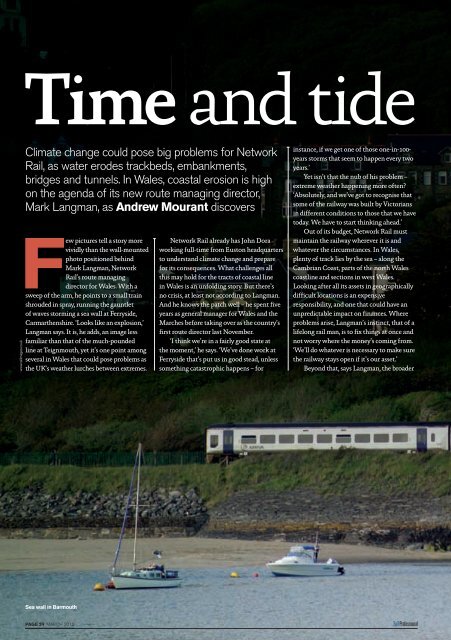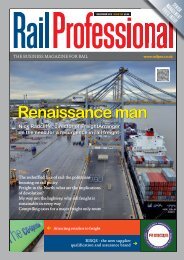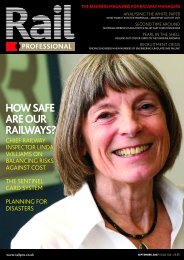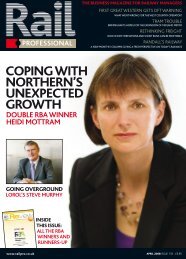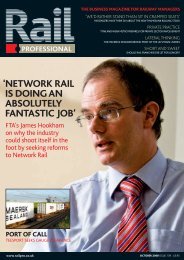View as PDF - Rail Professional
View as PDF - Rail Professional
View as PDF - Rail Professional
You also want an ePaper? Increase the reach of your titles
YUMPU automatically turns print PDFs into web optimized ePapers that Google loves.
Time and tide<br />
Few pictures tell a story more<br />
vividly than the wall-mounted<br />
photo positioned behind<br />
Mark Langman, Network<br />
<strong>Rail</strong>’s route managing<br />
director for Wales. With a<br />
sweep of the arm, he points to a small train<br />
shrouded in spray, running the gauntlet<br />
of waves storming a sea wall at Ferryside,<br />
Carmarthenshire. ‘Looks like an explosion,’<br />
Langman says. It is, he adds, an image less<br />
familiar than that of the much-pounded<br />
line at Teignmouth, yet it’s one point among<br />
several in Wales that could pose problems <strong>as</strong><br />
the UK’s weather lurches between extremes.<br />
www.railimages.co.uk<br />
Climate change could pose big problems for Network<br />
<strong>Rail</strong>, <strong>as</strong> water erodes trackbeds, embankments,<br />
bridges and tunnels. In Wales, co<strong>as</strong>tal erosion is high<br />
on the agenda of its new route managing director,<br />
Mark Langman, <strong>as</strong> Andrew Mourant discovers<br />
Network <strong>Rail</strong> already h<strong>as</strong> John Dora<br />
working full-time from Euston headquarters<br />
to understand climate change and prepare<br />
for its consequences. What challenges all<br />
this may hold for the tracts of co<strong>as</strong>tal line<br />
in Wales is an unfolding story. But there’s<br />
no crisis, at le<strong>as</strong>t not according to Langman.<br />
And he knows the patch well – he spent five<br />
years <strong>as</strong> general manager for Wales and the<br />
Marches before taking over <strong>as</strong> the country’s<br />
first route director l<strong>as</strong>t November.<br />
‘I think we’re in a fairly good state at<br />
the moment,’ he says. ‘We’ve done work at<br />
Ferryside that’s put us in good stead, unless<br />
something cat<strong>as</strong>trophic happens – for<br />
instance, if we get one of those one-in-100-<br />
years storms that seem to happen every two<br />
years.’<br />
Yet isn’t that the nub of his problem –<br />
extreme weather happening more often<br />
‘Absolutely, and we’ve got to recognise that<br />
some of the railway w<strong>as</strong> built by Victorians<br />
in different conditions to those that we have<br />
today. We have to start thinking ahead.’<br />
Out of its budget, Network <strong>Rail</strong> must<br />
maintain the railway wherever it is and<br />
whatever the circumstances. In Wales,<br />
plenty of track lies by the sea – along the<br />
Cambrian Co<strong>as</strong>t, parts of the north Wales<br />
co<strong>as</strong>tline and sections in west Wales.<br />
Looking after all its <strong>as</strong>sets in geographically<br />
difficult locations is an expensive<br />
responsibility, and one that could have an<br />
unpredictable impact on finances. Where<br />
problems arise, Langman’s instinct, that of a<br />
lifelong rail man, is to fix things at once and<br />
not worry where the money’s coming from.<br />
‘We’ll do whatever is necessary to make sure<br />
the railway stays open if it’s our <strong>as</strong>set.’<br />
Beyond that, says Langman, the broader<br />
Sea wall in Barmouth<br />
PAGE 24 MARCH 2012


